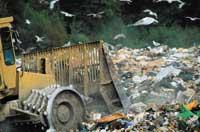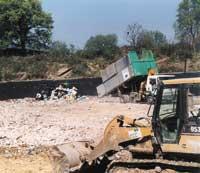Travel to the center of the landfill
Yes, but how do they build up in the landfill? And how long?

Not so long ago landfills were located approximately anywhere. It was selected as a landfill without thinking twice a small drain, a hole or a depression, quite far from the village. There the waste was stacked, waiting for them to ferment on their own and gradually disappeared. The study of environmental impacts, consideration of soil geochemical characteristics, waste management are relatively new. Of course, not as much trash was generated as today and most were organic matter.
Fortunately, throwing waste away from home has helped humans avoid many diseases, as rodents, insects and microorganisms multiply there. During the Middle Ages, microorganisms and rats raised in landfills spread the black plague in Europe, and still in the world's poorest countries cholera pests continue to exist because of waste contaminated water.
Uncontrolled landfills damage air, water, landscape, vegetation, fauna and human beings. If waste is burned, the particles found in the smoke can produce respiratory diseases and gases from the fermentation of garbage can be dangerous: methane is explosive and hydrogen sulfide has an unpleasant smell. In addition, water filtered downstream from the landfill absorbs soluble waste products (anything: mercury from batteries, pesticide residues, plastic components, etc.) and can contaminate the rivers or aquifers of the area. These liquids are called leachate and are usually very polluting.
Controlled garbage
Our garbage, in general, accumulates in controlled landfills where, although the main headache is gases and leachates, proper management does not generate problems. After the closure they remain under control for 30 years, but then they can become green areas or farmland.

The controlled landfill is the simplest waste treatment system: they are deposited, crushed, compacted, covered with soil and deposited in microorganisms. In the first days, aerobic fermentation occurs, that is, microorganisms work with oxygen, and when oxygen is exhausted, anaerobic fermentation begins. These processes generate the aforementioned products (carbon dioxide and nitrates in aerobic and carbon dioxide, water, ammonia, hydrogen sulfide, iron and manganese sulphides in anaerobic).
In low-density landfills waste is deposited in layers of 1.5-2.5 m thick and covered with land the same day. In high-density landfills, to prolong the aerobic fermentation phase, garbage is spread in narrow layers so that the air touches as much surface as possible. In high-density landfills, garbage is very compact and mixed over and over again, and although low-risk leachates are generated, they require a larger area than low-density ones.
Installation of gas collection and control chimneys and construction of a drainage network for the collection of bottom leachates. Leachates are treated in conjunction with urban wastewater in treatment plants (if the region is a treatment plant, of course), but in some landfills they give a pretreatment before being sent to the treatment plants. They do so in the landfill of the Commonwealth of San Marcos in Gipuzkoa, “but it is not easy”, says environmental technician Elena Egurrola, “with the treatment plant we have problems, since the flow and composition of leachates are very variable and also do not vary according to fixed parameters. What is collected today in the treatment plant is not the waste residue deposited yesterday, and the purification must be constantly adjusted.”
Gases, on the other hand, can be burned or used to obtain energy once collected. In fact, the gas generated in biological and chemical decomposition processes in medium and low density landfills is useful for electricity production. This gas, biogas, 50% carbon dioxide and 50% methane, although it also contains some nitrogen, oxygen, hydrogen and hydrogen sulfide. The composition may vary depending on the characteristics of the landfill, but in general, a ton of urban solid waste produces 3-15 m 3 of biogas per day.
Only essential in the landfill

Euskal Herria and all of Europe face a major challenge before 2006. In fact, the new directive states that only final waste can be brought to European landfills. Waste that can be recycled or otherwise used cannot be deposited in landfills, and organic matter must be treated. In addition, the funds of the landfills must be waterproofed with plastic (in the Basque Country, since the lands are mud, most landfills do not have waterproofing materials under the landfill). There are tasks.
How long will your trash bag disappear?
|
Where to put the landfill? Before the directive adopted for the whole of Europe, there was no specific legislation regulating landfills, the only reference was the regulations for annoying, harmful, unhealthy and dangerous activities of 1961. Landfills have therefore been subject to indirect regulation within the framework of measures to regulate environmental impact or water quality. The location of the landfill is selected first if it is located at a minimum distance from the cities, towns, coasts, rivers or roads and then a hydrogeological study of the site is carried out. A low-permeability terrain and adequate topography will be selected to ensure that leachates are not poured into channels or aquifers of any kind. Although the ideal is to waterproof the bottom with plastic, so far it has been possible to build landfills not waterproof in clay lands. It should also be verified that there is no risk of flooding or detachment at the site and, finally, to ensure minimal landscape alteration. |





